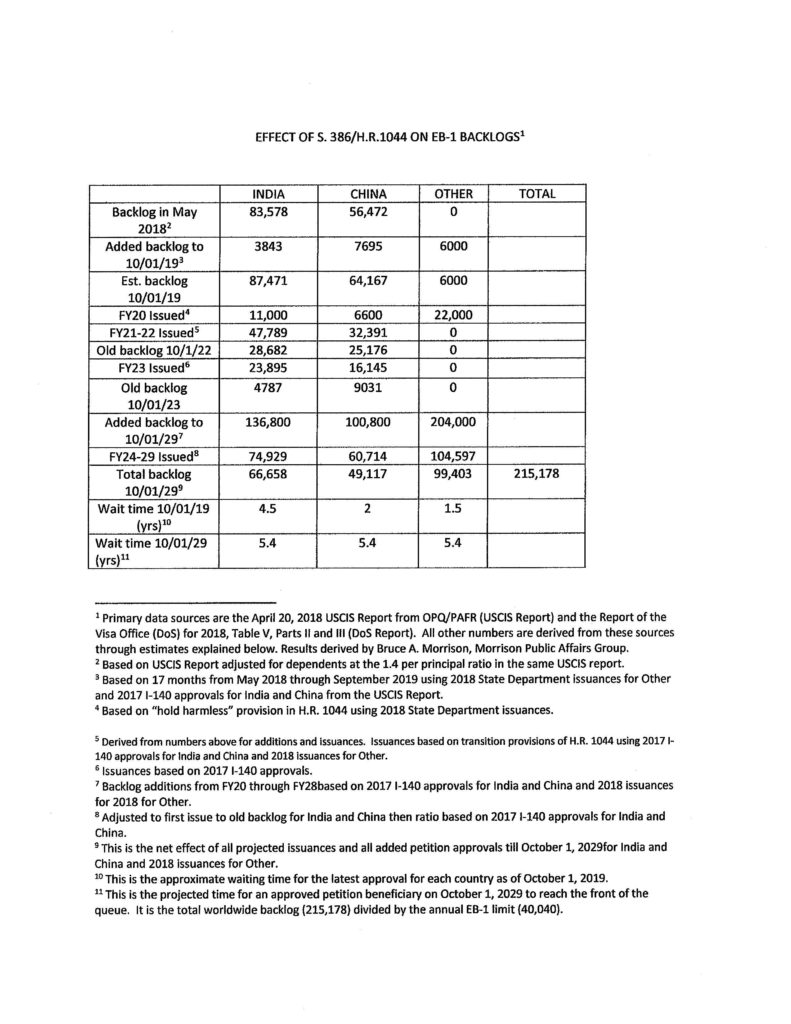At the same time the Trump White House is crushing the hopes and aspirations of asylum seekers and those seeking a better life in. the U.S. through illegal practices and policies, the Congress is about to seriously disrupt, if not end, immigration of high skilled workers into the U.S. for the foreseeable future. And they are doing it without every having a hearing on the effects of the legislation!
With lightening speed and without a single hearing, the House of Representatives passed HR 1044 back in July—the misnamed “Fairness for High Skilled Immigration Act”. This legislation has been around for years; a gift to the tech industry to grant permanent residency to Indian nationals, allowing them to use all available visas in the skilled worker categories for most of the next decade. Partly because some Democrats want to help friends in the tech industry while many Republicans hope to severely limit employment based green cards, but mostly because this legislation’s actual effect is not widely known, the bill has had bi-partisan support. But it is terrible public policy. It’s time to speak out.
For many years, Indian nationals in the computer fields have rightly complained that they are being held in limbo rather than becoming lawful permanent residents. This was never an accident. IT employers have a business model of hiring permanent immigrants on temporary visas. The current waiting time for residency is over 10 years. Do the math: in just one of the employment based categories (EB-2) allocated 40,040 immigration visas a year, there are already 550,000 nationals waiting for residency, of which 512,000 are Indian nationals. HR 1044 (and its Senate counterpart S.386) end per country distribution of green cards, which after a transition period, would essentially give all the visas to Indian nationals. This legislation does not add a single green card for any category.
A great deal of misinformation and outright lies have been spread about these issues. One is the claim that the backlog is the result of the “per country cap”, which (it is said} discriminates against people born in India. That is not true.
As immigration lawyers, we know better. The per country cap – which is really distribution, and not a limit on individual source countries -was enacted in 1965 to ensure that American immigration is open to individuals from all countries. A great irony of the way the current debate is so polarized — again, the result of a deliberate strategy by tech employers to spread false claims -is that the per-country distribution system in 1965 help to create significant immigration from India and many other countries in the first place. The “per country cap” replaced a quota system that explicitly discriminated against all nations outside of Europe (including India}, and even within Europe, e.g. Italy got far less visas than northern European nations.
Proponents for this ill-considered legislation often ask “Why should India with more than a billion people be limited to the same cap for green cards as Iceland, with 300,000?” We know that’s not how it works: the misleading “cap” rhetoric claims that no nation can get more than 7% of the total. Yet over the 10 years from 2007-17, Indian nationals received 280,523 employment-based green cards; Chinese nationals, 130,248; South Korean nationals, 115,274, and Philippine nationals, 84,792 green cards. China has a substantially larger population, yet workers born in India received more than twice the number of employment-based green cards than workers born in China. That India has gotten more than twice as many green cards as the world’s largest nation does not indicate a system biased against people born in India.
And Iceland? In 2016, it got 57 employment-based green cards. In 2017, 42. The ostensible “cap” which supporters of this zero-sum legislation claim sets aside 9,800 employment based green cards for Iceland, actually distributes more than 9,700 of that “cap” every year to high-demand countries – including India. The per country distribution system uses a “cap” that does not limit green cards to ensure they go to meet demand. Tens of thousands of immigration visas that the proponents of this legislation claim are withheld from India, actually go to Indians.
The backlog isn’t caused by per-country distribution. It’s caused by the overall number of employment-based green cards. There simply are not enough visas for the demand. The answer is not to fight over the few visas given each year; the answer is to have a larger number of visas to the benefit of the U.S. economy. Simply, we need more visas.
HR 1044 and S.386 in lifting the per country cap do not solve that problem. In fact, they simply make it worse:
First, high skilled workers in other areas – like health care and medical research, two areas of great significance to the nation-will be shut out of residency for well over a decade. Potential new Americans in basic science,engineering, chemistry, physics, artificial intelligence, climate change and many other fields who are not Indian nationals will be discouraged from ever coming to the U.S- people working to cure cancer and Parkinson’s, to fight climate change and create whole new industries.
Second, the waiting times for residency under HR 1044/5386 will go from 10 years (for Indians now) to 17 years for everyone after Indian nationals use the visas.
Third, even the Indians already backlogged will not all get green cards. There simply aren’t enough.
Fourth, this legislation would also potentially harm DACA and TPS recipients. If Trump is allowed to end these programs, those recipients who have been waiting for a transition to employment-based visas would suddenly be faced with having to leave the country and wait for green cards outside of the U.S. for up to 17 years!
The attached charts simply apply the language of S. 386 and H.R. 1044 to official State Department and USCIS data, as would be done publicly through a proper legislative hearing. Even counting shifts between categories, what’s now a 10.5 year delay for Indians will become a 17 year delay in ten years – and include the whole world: every source country, every profession and kind of skill. The total backlog for employment-based residency goes from over 800,000 today, to 1.1 million in 2029.
So a zero sum approach is no solution. Congress should not pit Indian nationals against the rest of the world. Congress should enact a system to make more permanent residency visas available, where healthcare (ad particularly in rural areas) and scientific research are acknowledged as priorities, a system that encourages skilled workers to remain in the US. The Ellis Island model that defines United States immigration means permanent residency and a direct route to citizenship. If the U.S. had treated Alexander Graham Bell in the 19th century the way this legislation would treat him in the 215 he’d have invented the telephone in Canada.
Senator Rand Paul has introduced legislation to actually solve the problem - the BELIEVE Act-by doubling the number of visas, by ending the ridiculous process of counting spouses and children of high skilled workers when allocating visas, by giving some limited priority to health care workers in rural areas, and by allowing early filing of residency for such high skilled workers. There are other discussions in the Senate involving both Republicans and Democrats focused on actually solving the green card backlog for Indian H-1B workers without hurting the rest of the world. This should not be a case of choosing IT workers over nurses or doctors; Indians over the rest of the world. The national interest is to give green cards quickly to those beneficiaries who have qualified with their skills and shown that they are needed without displacing qualified American workers.
As members of the immigration bar, it is our responsibility to make the facts of these controversies clear.
The United States gets highly skilled immigrants from all over the world, in a wide range of valuable professions. Tech employers want to cut off all of that, simply because it is not IT workers from India. A single industry wants to sole source American immigration policy at the expense of health care, cutting edge research, and well, the whole world. Congress should at least hold a hearing before going over the cliff. |





